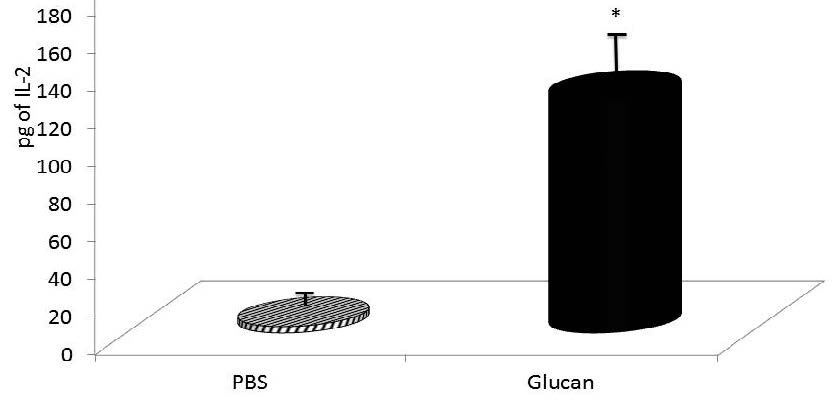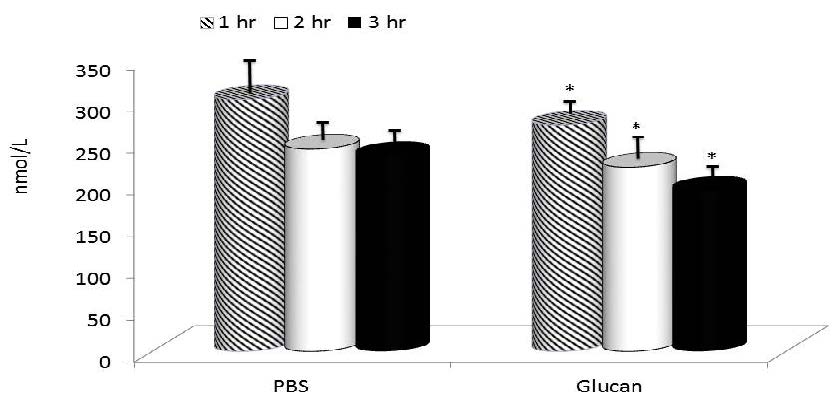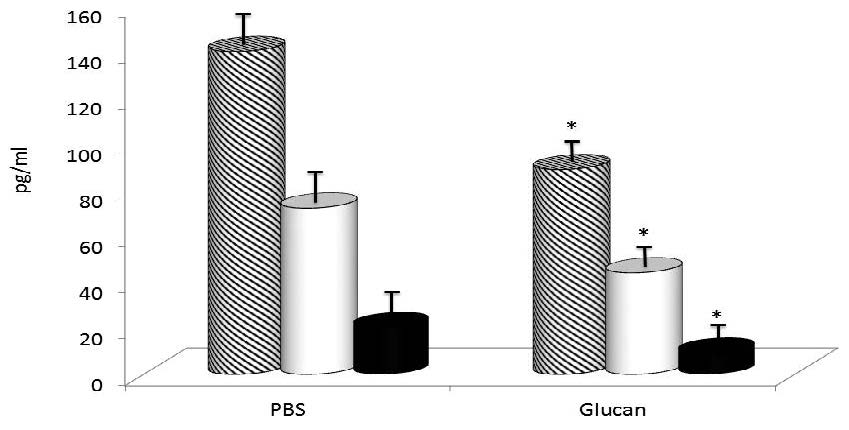Top Links
Journal of Nutrition and Health Sciences
ISSN: 2393-9060
β(1-3)(1-6)-D-Glucan with Strong Effects on Immune Status in Chicken: Potential Importance for Efficiency of Commercial Farming
Copyright: © 2014 Vetvicka V. This is an open-access article distributed under the terms of the Creative Commons Attribution License, which permits unrestricted use, distribution, and reproduction in any medium, provided the original author and source are credited.
Related article at Pubmed, Google Scholar
In face of the challenge of the emergent new diseases and the current efforts of the governments to ban growth-promoting antibiotics and to improve conditions and overall health of the farmed animals, new opportunities are created for natural, highly effective, cost affordable immunomodulators. Supplementation of animal feed with β-glucans has repeatedly been shown to modulate the immune system. In this study we focused on evaluation of the effects of new insoluble, fungi-derived β-glucan as dietary supplement in chicken. We found that his β-glucan has the potential to stimulate growth, phagocytic activity, and IL-2 production. In addition, it significantly lowered the levels of TNF-α and cortisol levels elevated by a lipopolysaccharide challenge.
Keywords: Glucan; Chicken; Fungi; Immunity; Phagocytosis; TNF-α
For the past 40 years, β-glucans have drawn ever increasing attention due to their immunomodulatory capabilities in the innate immune system. Various types of glucans have been isolated from yeasts, mushrooms, grain and seaweed. They have been extensively studied for their immunological and other biological effects. Currently in the literature, there exist more than 8,000 papers describing the mostly immunological activities of glucans [1]. However, in addition to the effects on the immune system, glucans were found to influence cholesterol level [2], blood sugar [3], and protect against bone marrow damage [4] and stress [5].
Glucans were found to be active throughout the animal kingdom, ranging from earthworms to humans [1], thus making glucan one of the oldest and at the same time most common immunomodulator. Although β-glucans were initially considered to be a stimulator of cellular immunity only, researchers lately demonstrated that their biological effects are pleiotropic. It is not surprising, therefore, that glucans have routinely been used in animal farming; in fish [6], shrimp [7] and in pig feed [8]. In face of the current efforts of various governments to ban growth-promoting antibiotics in chicken, attention focused on the possible use of glucan in chicken. Subsequent studies revealed that glucan addition was found to reduce the severity of Eimeria infection [9], to lower cholesterol [10], to upregulate the phagocytosis of macrophages after bacterial infection [11] and to improve growth performance [12].
In the present paper we focused on evaluating the effect of adding the glucan, previously tested in a trial with dogs [13], into the commercial feed of chicken. We tested the effects of glucan addition on weight, phagocytosis, levels of interleukin-2 (IL-2), cortisol and tumor necrosis factor alpha (TNF-α) in blood.
At the beginning of the study, the animals were examined for signs of any disease and all were considered healthy on the basis of a lack of clinically relevant abnormalities. The animals were then randomly assigned to individual groups. None of the used animals developed any disease including lethargy, fever or gastrointestinal problems during this study. Similarly, none of these animals either died or were euthanized during this study. The use of animals was approved by the University of Louisville IACUC committee (#12029). Leghorn chickens were purchased from (Hy-Line International, Bryan, TX, USA).
Lipopolysaccharides (LPS from Salmonella enteriditis), Wright stain, and sodium citrate were obtained from Sigma (St. Louis, MO, USA).
Yeast-derived glucan was isolated from Saccharomyces cerevisiae and is 55.5% pure (Biorigin, Brazil).
High protein DuMOR® Chick Starter 24% (Purina, Harrisburg, PA) was used. The composition of the diet is given in Table 1. Weekly body weight was recorded and treatment dosages adjusted accordingly. Chicken feed was supplemented with 25 mg of BG/kg/day.
Phagocytic activity was evaluated as described earlier [14,15] using synthetic polymeric microspheres based on 2-hydroxyethyl methacrylate. Briefly: 0.1 ml of peripheral blood (with sodium citrate 1:9) was incubated in vitro with 0.05 ml of particles (diluted at 5x108/ml). The test tubes were incubated at 37 oC for 60 min., with intermittent shaking. Smears were stained with Wright stain. The cells with three or more particles were considered positive. All experiments were performed in triplicate. At least 300 cells in 60 high power fields were examined in each experiment.
Levels of IL-2 were evaluated in serum (prepared from 1 ml of collected) at the end of the experiment using a commercial IL-2 ELISA kit as recommended by the manufacturer (Genorise Scientific, Paoli, PA).
Levels of TNF-α were evaluated in serum (prepared from 1 ml of collected blood) at 1, 2 and 3 hr after injection of LPS 14 days after beginning of feedings with glucan. The level of TNF-α was measured by a commercial ELISA kit (Biotang, Waltman, MA) according to manufacturer instructions.
Levels of cortisol were evaluated in serum (prepared from 1 ml of collected blood) at 1, 2 and 3 hr after injection of LPS 14 days after the beginning of feedings with glucan. The level of cortisol was measured by a commercial ELISA kit (MyBioSource, S. Diego, CA) according to manufacturer instructions.
Chicken were fed with the commercial diet (Table 1) with or without glucan for 28 days. Weights were determined weekly to calculate ADG (average daily gain) and ADFI (average daily feed intake; data not shown).
Data were analyzed by ANOVA using the GLM procedure appropriate for a factorial arrangement of treatments in a randomized block design. The statistical model included the effects of challenge (LPS) and/or dietary supplements. The pen was used as the experimental unit for analysis. A level of P≤0.05 was used to indicate statistically significant results.
Body weights were recorded every week for the entire duration of the experiment. Average daily gains were calculated for each of the 7 day periods. The ADG was significantly influenced by the addition of glucan (Figure 1).
Glucans were originally discovered as non-specific stimulators of cellular immunity, which is manifested mainly by action of macrophages. Phagocytosis is considered to be one of the main defense reactions, and subsequently it is a reaction where possible immunostimulating effects of glucan are tested first. In our experiments we used phagocytosis of synthetic microspheres based on 2-hydroxyethyl methacrylate which are known for minimal false positivity [14]. Our results showed that addition of glucan significantly potentiated phagocytic activity of both peripheral blood monocytes and neutrophils in both models (Figure 2). Experiments evaluating the effects of glucan on IL-2 production in blood showed that feeding with glucan significantly increased the level of IL-2 (Figure 3).
The next experiments tested the effects of glucan supplementation of the response after a lipopolysaccharide challenge. First, we measured the levels of the stress hormone cortisol. We found that addition of glucan to the feed significantly lowered the cortisol levels in all three tested intervals (Figure 4). These experiments were followed up by studies measuring concentrations of TNF-α after LPS challenge. Our data summarized in Figure 5 showed that addition of glucan resulted in significant reduction of TNF-α levels in all three tested intervals.
The present study evaluates the effects of the addition of yeast-derived glucan based on immune reactions of the chicken. We found higher ADG when given glucan, which is in agreement with previous findings [12].
The exact mechanisms for these effects are not clear, because the energetic contribution of the glucans to the feed at dosages used is negligible. Among possible explanations might be stress reduction, effects on gastrointestinal tract microbiota [16] on gut permeability [17] and reduction of the negative effects of LPS on feed intake. However, these effects will depend on type of glucan used, since barley-derived glucans have negative effects on the digestive tract of chicken resulting from increased intestinal viscosity [18]. Glucan has been found to strongly influence chicken blood cell functions, including induction of oxidative burst response, which was mediated via Dectin-1 receptor [19]. Similarly, addition of glucan to the chicken feed stimulated phagocytosis and bactericidal activity of abdominal macrophages [11]. Our data further stressed the glucan effects on stimulation of phagocytosis by peripheral blood neutrophils and monocytes. Strong stimulation of IL-2 production suggested activation of T lymphocytes with subsequent differentiation and maturation on NK cells [20], which is in agreement with previously found effects of glucan and can have serious implication for infection risk [21]. In addition, glucan was found to reduce severity of infections [9] and to improve production in chicken challenged with Escherichia coli [22].
Farm animals are naturally and constantly challenged by LPS during their production period. Even in simpler events, as subclinical diseases or high fiber feeding, higher levels of LPS are produced. LPS is known to stimulate proinflammatory response, higher TNF- induced cell monolayer disruption and higher tight junction permeability to the intestinal epithelium, leading to higher leakage of LPS into the blood and the initiation of a cycle of inflammatory response [23]. LPS-induced response was shown to be modulated by vasoactive mediators such as nitric oxide, a vasodilator produced by endothelial cells and monocytes and macrophages, and serotonin, a vasoconstrictor released by thrombocytes. It has a potential to impair feed intake and immune status including changes in activity of regulator cells [24] which might result in the reduction of the production efficiency [25].
Glucan is well known to be a significant stimulator of immune reaction and these effects were repeatedly observed regardless the route of administration [26] or animal species. For evaluation of the potential effects of our glucan samples on phagocytosis, we used polymer microparticles based on hydroxymethacrylate, which, due to their negative charge, guarantee minimal false positivity [15]. Our results showed significant stimulation of phagocytosis by both peripheral blood monocytes and neutrophils, which is in agreement with previous finding in mice [26] and pigs [13].
We focused on the effects of glucan supplementation after LPS challenge and found that both cortisol and TNF-α levels were significantly lower, suggesting the protective effects of glucans administration, which is in agreement with previous results achieved in similar model of LPS challenge after weaning [27]. The glucan effects found in our study were even stronger than those reported by [28], which might be caused by either use of different glucans or by differences between avian and mammalian immune system. In general, however, our data showed that addition of glucan to the chicken feed can significantly improve the animal's response to the LPS challenge.
The fact that glucan is anti-inflammatory matches very nicely with the findings on IL-2, and with findings on iNOS by others [9]. The inflammatory state is more likely to be feed derived [29], and it is established that anti-inflammatory agents can lower that, thus saving energy for growth [9,30].
It should be stressed that results described in this study might be potentially significant for vaccination in poultry. Poultry have a rather limited number of resident macrophages in the normal steady-state respiratory tract and must rely on migration from other organs. The stimulation of this cell migration is one of the well-known characteristics of glucan [1] and the migration of glucan-stimulated phagocytosis might be particularly important in case of infection [31].
In conclusion, glucan had significant immunomodulating effects in our model, strongly suggesting that supplementation of feed with this glucan results in improvement of both general and immunological conditions of chicken. In addition, with current efforts to ban on antibiotic and growth promoters, the use of glucan as feed additive offers two benefits—natural growth stimulation and natural protection.
 |
| Figure 1: Average daily gain. At least 16 chicken were evaluated at each experimental group. Each value represents the mean ± SD |
 |
| *Represents significant differences between control (PBS) and tested samples at P ≤0.05 level Figure 2: Effect of dietary supplementation with glucan samples on phagocytosis by peripheral blood monocytes and neutrophils in chicken. Each value represents the mean ± SD |
 |
| *Represents significant differences between control (PBS) and tested samples at P ≤0.05 level. All experiments were performed in triplicates Figure 3: Effect of dietary supplementation with glucan samples on IL-2 level in serum of chicken. Each value represents the mean ± SD |
 |
| *Represents significant differences between stressed-control (PBS) and glucan samples at P ≤0.05 level Figure 4: Effect of addition of glucan to feed on LPS challenge-induced levels of corticosterone in chicken |
 |
| *Represents significant differences between stressed-control (PBS) and glucan samples at P ≤0.05 level Figure 5: Effect of addition of glucan to feed on LPS challenge-induced levels of TNF-α in chicken |
| chicken | % |
|---|---|
| Crude Protein | 24.00% |
| Crude Fat | 2.50% |
| Lysine | 4.50% |
| Methionine | 0.50% |
| Calcium | 1.25% |
| Phosphorus | 0.80% |
| Salt | 25% |
| Ruminant meat and bone meal free. | |
| Based on manufacturer's information. Table 1: Diet composition |
|














